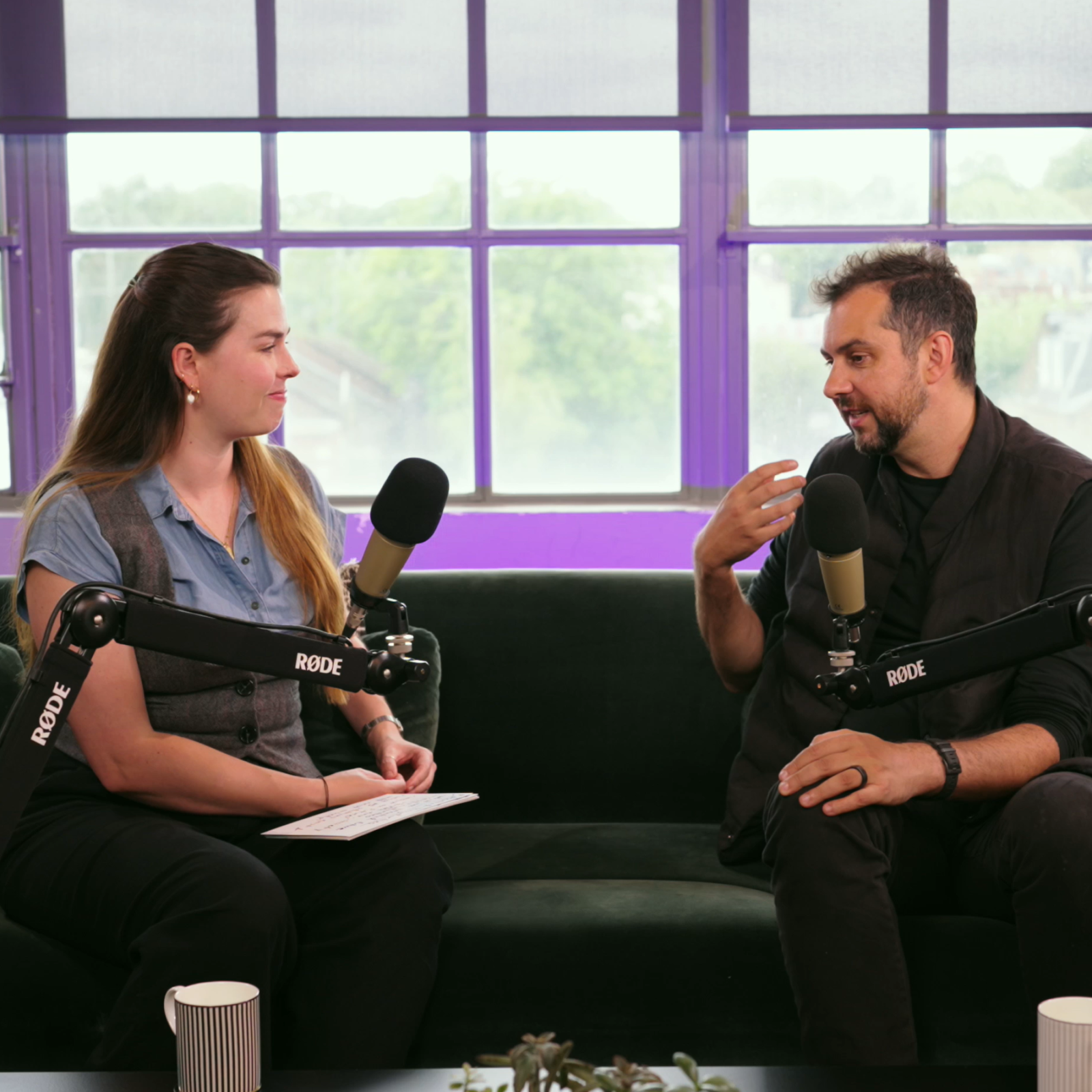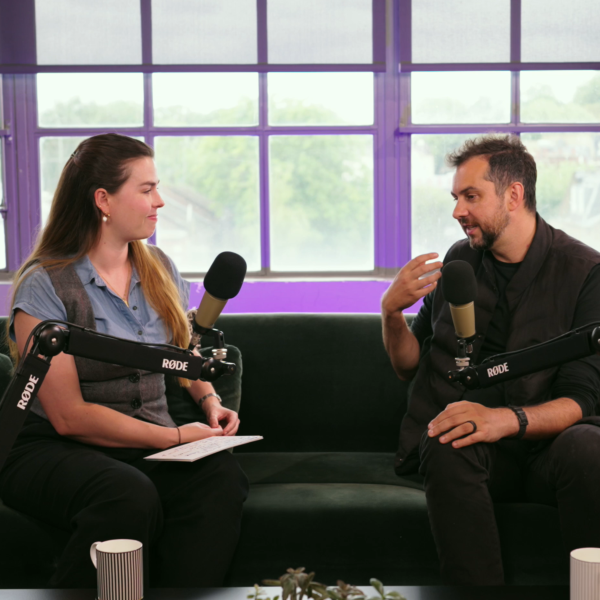by Satalia Team
13 June, 2025
AI in marketing: what do businesses need to know?

Right now, AI is reshaping marketing campaigns…in literal real-time
Personalised content in seconds. Campaigns pre-flight tested on synthetic audiences. Brain-like AIs that create, test and optimise ads at a scale no human team could match. Marketing is becoming a science, powered by AI.
Satalia CEO and WPP Chief AI Officer Daniel Hulme sat down with science & tech communicator Maren Hunsberger to explore how artificial intelligence is transforming the marketing world – from dynamic segmentation to multimodal content to real-time ROI. Here’s what they discussed…
MH: So Daniel, in this world of growing complexity where brands want to personalise their marketing, how can AI help them do that?
DH: Well, first of all, I think there are some industries that are relatively immune to the disruption of AI. We’re going to make things faster, cheaper, better. But media, marketing, communications is being completely disrupted by AI. We can now create ads hundreds or potentially thousands of times faster than previously.
So really, what we’re looking at is how do we apply AI to solving problems across the marketing supply chain to make sure you’re getting the right ads to the right people at the right time? That’s the fundamental challenge to solve for. As far as I’m concerned, there’s a huge amount of opportunity to service that need: to make sure that the right brands, the right products and services are being made available to the right people.
MH: So how can brands use AI tools like these to maintain brand consistency, especially if we’re looking at delivering this content over different channels or even in different markets completely, like localising the content?
DH: Well, if you look across our supply chain, there are broadly three types of activities. One is the creative aspect; coming up with ideas, campaigns, etc. The second is creating production-grade content. And the third is pushing that content across channels to maximise return on investment. There is an opportunity to hyper-personalise content now because of AI, but I would argue that if we think about some of the ads that are memorable to you, those ads were not necessarily targeted specifically for you – they are shared moments in communities.
We have to get the balance right between personalisation, which in some cases makes sense. But also, how can we create shared moments?
There are broadly four underpinning AI services that serve those three parts of our supply chain. The first is being able to create content rapidly. We call those brand brains. The second is being able to understand how people perceive content. We call those audience brains. The third is predicting the activation – the clicks, the likes, the sales that we’re going to get from that content. And the fourth is then pushing that content and optimising it across channels to maximise return on investment.
Now, there are other AI services like creativity and identifying moments, which we can also talk about later on.
MH: What is a “brain” in this context?
DH: A brain is a bit like a human brain. It’s a specialist entity that can do one job very well. So when we talk about brand brains, if you go to ChatGPT or DALL·E or any of these large language models and ask it to create an ad for a product, it won’t really know what you’re talking about. It might get the colours and things like that, but it won’t understand the nuances of the brand guidelines, the tone of voice, etc.
So a brand brain is an AI that can now produce almost production-grade, brand-specific, differentiated content. When our creatives are coming up with ideas, they’re now able to create content that’s 90 to 95 percent good. That brain is actually made of different components, a bit like our brains, which have different lobes (I’m going to stretch the analogy here). We might have within that brain different specialisms…
Now let me just geek out a second because I think this is important. A large language model is a little bit like a graduate. You can get better results from that graduate by asking better questions – that’s “prompting.” But you won’t be able to ask a perfectly good question to create an ad. So asking better questions only gets you to about 20% good.
The second way of making a graduate smarter is by giving it your brand guidelines, your tone of voice, lots of examples of your imagery, etc. You ask it questions and it tries to answer them based on what you’ve given it. That gets you to about 40% good.
The next way of making a brain smart is turning that graduate into a professor or an expert at your brand. That currently takes weeks in the AI world. We know how long it takes human beings to go from graduate to professor; it takes years of training and experimentation.
What we do when we’re creating brand brains is we create a consortium of professors: a professor that’s an expert at your tone of voice, one for imagery, one for your culture and values. And the trick is: how do you get all these different experts coordinating and collaborating to produce content that is now 95-100% good?
So brand brains are ultimately trying to create content that is usable as ads.
MH: You’ve made a “brain committee” to optimise your content?
DH: Absolutely. In the same way that in the real world, you don’t typically have one person creating an ad. You need to pull together different experts to create excellent content.
MH: And how can AI tools like that help with something like brand consistency, especially across channels – again, when we’re trying to personalise – like social media or localising for a different market?
DH: That’s a great question. Brand brains are not only good at creating content, you’re able to test content against them to see if it aligns with your brand guidelines. Ensuring compliance across large organisations is very hard. So what we’re seeing is these brains not just creating content but ensuring that content is compliant.
The exciting thing is they’re able to tell you what you need to change in that content to make it compliant. So it’s enabling us to create brand consistency across different jurisdictions and products, and doing that very rapidly.
MH: So when we talk about building an audience brain and understanding all these things about them, where are we getting that information?
DH: Really insightful question. I usually turn it around: if you had a graduate sitting next to you that you wanted to become an expert in a particular audience, what data would you get them to consume? It depends on the product and the channel. For example, if you’re selling on Amazon, Amazon reviews are a great place to identify shopper barriers, how people feel about your product and competitor products.
There are also horizontal data sources – Reddit is fantastic for understanding general audiences. So we augment external data with massive internal audience data, plus insights from behavioural and organisational psychologists. Where there isn’t data, we gather it – surveys, etc.
The key is ensuring you have the right data. That’s the differentiator.
MH: When we’re thinking about audience brains and the other kinds of brains you mentioned, how can they be used to help predict the success of a campaign, especially compared to traditional trial-and-error or beta testing?
DH: Audience brains are synthetic audiences, like focus groups you can test content against rapidly. Let’s say I’m creating an ad for a horror movie and my assumption is that making people feel excited and scared leads to clicks. A synthetic audience can tell me: “Does this make you feel excited and scared?” That’s step one.
Then you use those signals plus other data – historical performance, etc. – to build a performance brain. The performance brain not only predicts activation, but, thanks to machine learning, can explain why. The classic example: if I show an ad with a black cat, it can predict clicks. But it can also say, “Change the cat to ginger because this audience likes Garfield.” That’s the power of ML. Humans may miss those correlations.
MH: So the AI can help predict performance and also suggest changes for greater impact?
DH: Exactly. And now you can see that the power isn’t in the brains working in isolation, it’s how they collaborate. The performance brain says what to change, the brand brain makes it happen.
MH: How can AI tools like these help brands optimise spend across multiple platforms and customer touchpoints while allocating resources efficiently?
DH: Let’s recap:
Brand brains use large language models to create content.
Audience brains use LLMs to understand perception.
Performance brains use ML to predict and explain activation.
Channel brains allocate content across channels based on constraints.
Channel brains are a different field – not generative AI or ML, but operations research. That’s where Satalia excels. If you have five pieces of content for five channels, that’s 120 possible combinations. With 60 pieces, the number of options exceeds atoms in the universe.
WPP pushes thousands of pieces of content across thousands of channels every second. Doing that well requires bleeding-edge optimisation. Channel brains help maximise ROI, and then feed back to the other brains.
These brains, combined, power our end-to-end marketing operating system, WPP Open. We’ve moved from a paradigm of creating ads in weeks or months to doing so in seconds.
That raises new challenges, like compliance and responsibility.
MH: How does this all come together to assess impact?
DH: Ultimately, success is in the proof: if we can show improved ROI versus previous methods. Our performance brain embedded in Commerce Studio (part of WPP Open) has delivered around 40% uplift. WPP guarantees a 25% uplift, but we’re often seeing more.
AI lets us apply the scientific method to marketing. Input X, get result Y, measure, and improve.
MH: What about before building an audience brain, like identifying new segments?
DH: Good point. Identifying emerging segments is critical, and it’s a different AI application. Generative AI, ML, data analysis, all play a role. Segmentation was historically static. Now it’s dynamic. Channels evolve, audiences grow. Dynamic segmentation helps inform audience brains, which then inform content.
MH: So you’re not stuck with outdated audience models?
DH: Exactly. Real-time feedback uncovers new segments, so you’re not creating content for a group that’s no longer relevant. Segmentation is the glue between media and brand strategy. AI is now bringing those two worlds together.
MH: Once we’ve identified new segments, how can we personalise content for them?
DH: Build audience brains. The key is identifying the right data sources to build representative audiences.
MH: What about inclusivity and accessibility?
DH: Very important. At Satalia we’ve done projects using AI to make ads more accessible, e.g. for people who are hard-of-hearing or visually impaired. We worked with Microsoft to analyse short-form ads, narrate visual gaps, and synchronise this with the audio for better accessibility.
This benefits everyone, not just people with impairments. These tools are multimodal – they can generate imagery, text, and sound, making content more accessible to more people.
And we must ensure inclusivity, not excluding communities. That’s where ethical or responsible brains come in.
MH: What about trust and safety, both in data and content?
DH: We have rigorous governance to ensure we’re using models appropriately across the supply chain. Our infrastructure ensures data is secure and not leaked. We’ve built frameworks to mitigate risks, including not just when AI goes wrong, but when it goes very right.
Why? Because AI can reinforce social bubbles. Humans have a bias called “homophily” – we like things that resemble us. If AI over-optimises, it might lead to “you selling to you,” reinforcing bias. That’s why we build brains that represent different corners of society – minority groups, political parties, cultures, compliance regulations.
For example, we’ve built a greenwashing brain. It flags claims about sustainability that may be false, or prompts you to adjust the claim to make it accurate.
MH: So these tools can build trust, ensure inclusivity, and boost performance, all in real time.
DH: Exactly. And it’s essential we keep humans in the loop, especially where the AI lacks confidence. Responsible deployment of AI is at the heart of everything we do.
Speak to an expert Satalia advisor today about maximising ROI through AI-driven marketing.
Stay in the know
Join our community now for the latest industry news, trends, valuable insights, and updates on our products and services.


